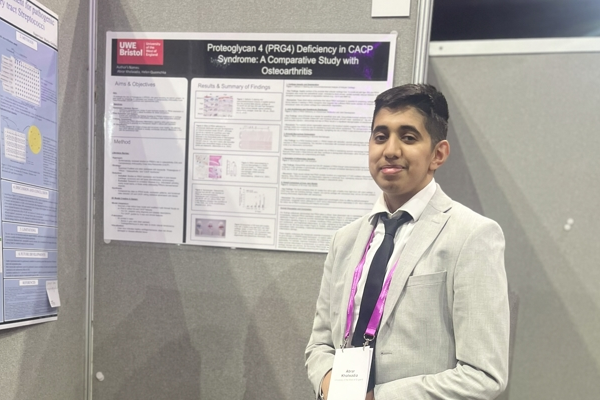Lubricin probe could open up avenues for treating rare genetic disorder with no cure

An investigation into a protein that helps to lubricate human joints could help to open up new avenues for treating a rare genetic musculoskeletal condition that has no current treatment.
A systematic literature review presented at the Minoritised Life Scientists Future Forum has illuminated the important role of lubricin in maintaining synovial joint homeostasis and its relevance for patients with Camptodactyly-Arthropathy-Coxa Vara-Pericarditis (CACP).
Abrar Kholwadia, of the University of the West of England, won a poster prize for his research project, entitled ‘Proteoglycan 4 (PRG4) Deficiency in CACP Syndrome: A Comparative Study with Osteoarthritis’.
“CACP is a rare genetic musculoskeletal condition with no current treatment, and results from a loss of lubricin expression. This review highlights the pivotal roles of lubricin in joint health, with the aim to identify a novel therapeutic intervention for CACP,” Abrar said.
“Joint degeneration and inflammation cause immense suffering in individuals with CACP. Despite early genetic diagnostics, patients with CACP endure debilitating symptoms, ranging from restricted joint movement to severe inflammatory episodes, and there remains a dire lack of effective treatment.
“CACP is not well understood due to its rarity - however osteoarthritis (OA) is a well-studied, highly prevalent joint disease, and shares pathological features with CACP such as synovial hyperplasia and joint damage. This review therefore aimed to highlight the key discoveries related to lubricin and the overlapping pathologies of OA and CACP.”
A literature search was performed in PubMed. Using set inclusion and exclusion criteria, in vivo and in vitro studies which focused on the role of lubricin in joint tissues (cartilage and synovium) and joint tissue cells (chondrocytes and synoviocytes) were selected. In order to support in person communication of different joint pathologies, 3D models were created using Nomad Sculpt to depict anatomical differences in healthy, osteoarthritic, and CACP-affected knee joints.
The review found that optimal lubricin expression preserves cartilage integrity and protects from arthritic degradation; maintains chondrocytic phenotype in the superficial, lubricating layer of cartilage; protects the synovial membrane from macrophage infiltration and inflammation; and dampens synoviocyte inflammatory signalling pathways.
“Taken together, these findings suggest that the absence of lubricin in CACP may result in a chondrocyte phenotypic shift and loss of protection against cartilage degradation; as well as drive synovial inflammation and synovial hyperplasia,” Abrar said.
“Understanding these pivotal roles of lubricin opens new avenues for therapeutic innovation for CACP and potentially improve outcomes for individuals affected by this challenging disease.”
Abrar said the complexity of the role of lubricin was particularly striking: “It was surprising to see how even minor deviations in expression or function can provoke a cascade of adverse effects, suggesting that mutations in PRG4, the primary gene responsible for encoding the lubricating protein lubricin, may contribute to the spectrum of symptoms seen in CACP, rather than a single, uniform disease presentation.”
These discoveries highlight the therapeutic potential of precisely modulating PRG4 expression using cutting-edge gene therapy or CRISPR-based techniques, he said. Such interventions could mitigate excessive inflammation and joint damage; offering new hope for those suffering from CACP by reducing pain and improving quality of life.
“Further research is essential to refine gene therapy approaches and fully map the spectrum of CACP symptoms. Expanded clinical studies will be crucial to validate these findings and develop effective treatment modalities,” he added.
This systematic review was led by Abrar Kholwadia, with invaluable support from Helen Quasnichka.



